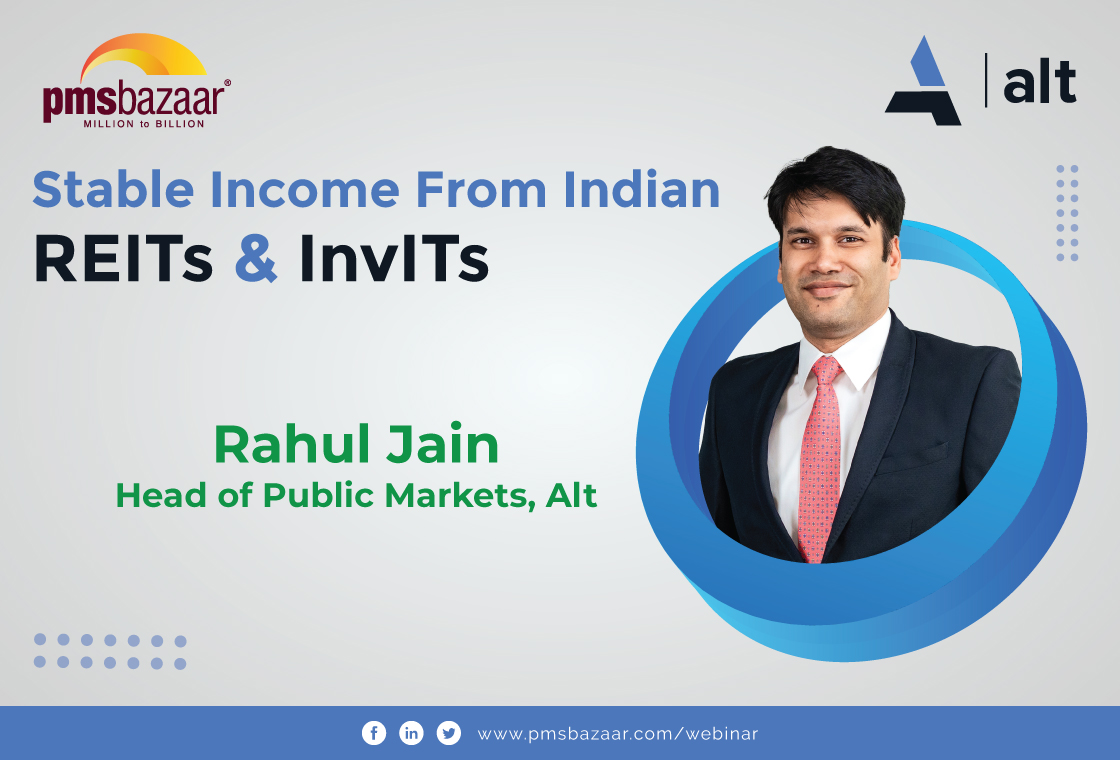PMS Bazaar recently organized a webinar titled “Alpha from Simplicity: The Power of Vanilla Investing,” which featured Mr. Sheetal Malpani, Chief Investment Officer and Head of Equity, Tamohara Investment Managers. This blog covers the important points shared in this insightful webinar.

The webinar blog covers insights from Mr. Mr. Malpani, which includes his advocacy for “plain vanilla” investing—simple, fundamentals-driven, and hype-resistant strategies. Using ice cream metaphors, he emphasises long-term wealth creation through quality businesses, sustainable cash flows, and patience. He highlights opportunities in premiumisation, private capex revival, and innovation in mid-caps, while warning against market noise, misleading trends, and over-diversification.
Key aspects covered in this webinar blog are
- Avoid Market Noise, Focus on Earnings and Fundamentals
- Don’t Judge a Business by Its Surface Appeal
- Consistency from “Boring” Businesses Pays Off
- Unseen Innovation in Small and Mid-Cap Firms
- Don’t Overdo the Toppings: Stay Data-Driven in Thematic Investing
- Discovering Underestimated Sectors and Revival in Private Capex
- Identifying High-Quality Businesses
- Understanding Sustainable vs. Temporary Cash Flows
- Prioritising Rate of Change Over Size
- Value of a Pre-Mortem Approach
Mr. Malpani started the session by sharing a compelling analogy between investing and ice cream. Just as vanilla remains the most timeless and reliable flavour despite countless innovations, he suggested that simple, principle-based investing, what he termed “plain vanilla” can help investors build significant long-term wealth. While markets constantly promote new trends and flavours to lure investors, success often lies in resisting the temptation to chase them.
He explained that just like ice cream parlours create exotic new offerings to attract customers, the equity market frequently introduces new themes to ride the wave of investor sentiment. But much like bubble-gum or rainbow-cookie ice cream, not every flavour is worth the hype. He urged investors to recognise that while interest in equities has surged post-COVID, deeper data on SIP inflows reveals a more moderate picture. Gross numbers may look impressive, but net figures tell a story of cautious participation, emphasising the need to stay grounded.
Avoid Market Noise, Focus on Earnings and Fundamentals
One of Mr. Malpani’s strongest points was that markets ultimately move in line with earnings growth, not excitement. While liquidity-driven rallies may temporarily push valuations above fair value, such movements are rarely sustainable. Instead of chasing social media-driven narratives like “the next mega trend” or “the next multibagger,” he recommended focusing on actual business performance.
Citing recent IPOs, Mr. Malpani pointed out that many hyped-up offerings have disappointed after listing. In contrast, companies from traditional sectors—like telecom, pharma, and technology—have delivered stable returns. The lesson was clear: fundamental strength matters more than flashy positioning.
Don’t Judge a Business by Its Surface Appeal
Mr. Malpani warned investors against basing decisions on superficial metrics like rising profits or attractive P/E ratios. Drawing a parallel with eye-catching but unhealthy ice cream, he explained that some companies might appear profitable but may be constantly raising equity, thereby eroding shareholder value.
He cited the example of a real estate company whose financials looked solid, but which consistently diluted equity, making it a poor long-term investment despite the perception of success. He emphasised the importance of analysing free cash flows, balance sheets, and shareholder behaviour before committing capital.
Consistency from “Boring” Businesses Pays Off
Mr. Malpani highlighted that many of the best performers in his portfolio came from “boring” industries. A packaging company, for example, with no tech buzz or AI angle, had compounded profits at 16% annually over a decade without any equity dilution. Despite lacking glamour, it consistently grew and delivered returns that outpaced many market darlings.
He explained that such businesses serving FMCG, alcohol, or tobacco sectors—may not be attention grabbing, but they demonstrate resilience and reward patience. Even during COVID-19, such firms continued growing modestly, underlining the value of stability.
Unseen Innovation in Small and Mid-Cap Firms
Challenging the myth that Indian small and mid-cap companies lack innovation, Mr. Malpani shared examples of businesses that transformed dramatically. One former TV parts manufacturer, nearly defunct in the early 2000s, reinvented itself into a global leader in electron beam welding serving clients like Tesla and BYD.
Another small-cap firm that had long specialised in peptides, well before they became the talk of the pharma world—now holds global records in protein manufacturing. These stories proved that serious innovation often comes from unlikely, under the radar players who simply work hard and stay consistent.
Don’t Overdo the Toppings: Stay Data-Driven in Thematic Investing
Mr. Malpani extended his metaphor to toppings on ice cream. Just as too many can spoil the taste, overexposure to trendy sectors like defence may lead to imbalanced portfolios. While defence spending is rising in absolute terms, he pointed out that it remains flat as a percentage of GDP. Therefore, investing based on popular themes requires rigorous analysis, not blind belief.
He added that many investors fail to align their time horizons with the businesses they invest in. Several companies that are now delivering 50–60% annual returns spent years in slow growth after their initial capex cycles. Investors need patience to let such businesses mature.
Discovering Underestimated Sectors and Revival in Private Capex
Mr. Malpani began by reiterating his confidence in equities as a favourable long-term asset class, particularly in a growth-driven economy like India. He stressed that as nominal GDP translates into rising corporate profits, equities should deliver solid returns over time.
He highlighted two thematic areas ripe with potential. The first is premiumisation, a trend that gained momentum post COVID-19 and reflects India’s growing appetite for aspirational consumption. Despite high valuations, he believes this theme will remain robust for the next 8–10 years, driven by increasing disposable incomes and evolving lifestyle preferences.
The second opportunity lies in a private sector capex revival. Mr. Malpani observed early signs of a turnaround in private investment, particularly in companies catering to capital expenditure such as OEMs and ancillaries. These players, aligned with a strengthening private capex cycle, are likely to witness structural growth over the next four to five years.
Unlocking Broader Private Sector Participation
The conversation shifted to what might drive broader private sector engagement in capital investment. Mr. Malpani detailed that between 2020 and 2024, government-led capex played a pivotal role in supporting economic revival. As results of public investment began materialising, private capacity utilisation improved, reaching 70–75% in core sectors.
Further, India's improved fiscal health, robust corporate balance sheets, and favourable policies like the PLI scheme are encouraging signs. He pointed out a notable shift: for the first time recently, private capex marginally outpaced public capex. This trend, he believes, will strengthen, especially with India positioning itself as a manufacturing hub under the “China plus one” narrative.
Identifying High-Quality Businesses
When asked how he defines a top-tier business, Mr. Malpani emphasised competitive advantage, operational efficiency, and scalability. High-quality businesses, he said, are not just local leaders but must withstand global competition, offering superior products or services not only on price but value.
He also stressed the ability to innovate through industrial cycles and adapt to changing client needs. Margins, cash flows, and prudent capital allocation were all key filters.
Understanding Sustainable vs. Temporary Cash Flows
Mr. Malpani warned investors against mistaking scarcity-driven price spikes for sustainable profitability. He cited COVID era pharma and API firms that benefited from one-off demand surges, which were not replicable.
Sustainable cash flow, he explained, typically stems from efficiency gains, better product mix, export growth, and market share expansion—not opportunistic windfalls. Ferrari like business models, with purposeful scarcity and constant demand, are rare and valuable exceptions.
Prioritising Rate of Change Over Size
According to Mr. Malpani, investors often err by focusing on absolute numbers rather than the rate of change. Using automotive and banking examples, he showed how market share gainers outperform peers, even in low-growth industries. PSU banks, for instance, outperformed post COVID due to rapid improvements in growth metrics despite private banks being fundamentally superior.
Managing Portfolio Concentration and Risk
On portfolio construction, he explained that there's no fixed rule for the number of stocks to hold. His team prefers a focused portfolio of 18–22 stocks. He compared excessive diversification to playing cricket with too many batsmen—safe but unimpactful. According to him, conviction should guide inclusion and the 25th idea rarely adds real alpha.
Value of a Pre-Mortem Approach
Sharing a lesson from a past investment, Mr. Malpani outlined his pre-mortem process, identifying risks before investing. In one case, they had flagged the risk of EV policy changes impacting a CNG company. When such a policy materialised, they exited swiftly, demonstrating the importance of having pre-defined exit criteria based on thesis invalidation.
On “Vanilla” Companies and Avoiding Hype
Responding to a question about "vanilla companies," Mr. Malpani explained that these are businesses with consistent performance, avoiding hype or buzzwords. They deliver steady returns, align words with actions, and remain focused on their core operations making them ideal for long-term investment.
Sector Outlook and Market Sentiment
On sectoral outlook, Mr. Malpani refrained from specific long-term bets but maintained optimism on India’s macroeconomic setup—sound currency, strong policy framework, and low inflation. He believes manufacturing will take the lead this decade, reversing the consumption heavy trend of the past.
He likened likely corrections to a T20 match quick and sharp, urging investors to stay disciplined and use dips to accumulate quality names.
Approach to Research and Red Flags
In terms of research, Mr. Malpani’s approach is rooted in on-ground intelligence, not just management meetings. His team examines vendor feedback, supply chains, and competitive landscapes. While they don’t explicitly search for red flags, poor performance despite industry tailwinds often indicates internal issues worth avoiding.
Views on IT, Pharma, and Market Fears
On IT and pharma, he was cautiously optimistic. While acknowledging that IT has underperformed recently, he believes niche players and R&D-driven firms offer upside. Pharma, being highly fragmented, requires case-by-case analysis.
As for biggest fears, he cited geopolitical instability as a concern, though he expressed confidence in India’s continued focus on growth.
Future of Small and Mid-Caps
In closing, Mr. Malpani reflected on the strong performance of small and mid-caps post-COVID, driven by earnings compounding at 20–23%. With stable valuations and improved retail participation, he expects continued outperformance in this segment, provided investors remain focused on fundamentals and avoid chasing momentum.
Mr. Malpani covered all the topics mentioned above in-depth and answered questions from the audience toward the end of the session. For more such insights on this webinar, watch the recording of this insightful session through the appended link below.
Get access to rich data and analytics of PMS & AIF by subscribing to us. Join the 75000+ investors & experts: Subscribe NOW
Recent Blogs
.jpg)
Passively Active Investing — A Modern Investor’s Lens on ETF-Based PMS
PMS Bazaar recently organized a webinar titled “Passively Active Investing — A Modern Investor’s Lens on ETF-Based PMS,” which featured Mr. Karan Bhatia, Co-Founder and Co-Fund Manager , Pricebridge Honeycomb ETF PMs. This blog covers the important points shared in this insightful webinar.

Spot the Trouble: Red Flags in Equity Investment Analysis
PMS Bazaar recently organized a webinar titled “Spot the Trouble: Red Flags in Equity Investment Analysis,” which featured Mr. Arpit Shah, Co-Founder & Director, Care Portfolio Managers. This blog covers the important points shared in this insightful webinar.

Long-Only AIFs Rebound Sharply in October; Long-Short Strategies Lag Despite Lower Volatility
106 long-only AIFs averaged 3.68% vs 32 long-short AIFs at 2.7%; only 24–31% of funds beat key indices

Markets log strongest monthly gains in 7 months; PMS performance turns near-uniform in October
Nifty 50 TRI gained 4.62%, BSE 500 TRI rose 4.27%; 415 of 427 equity PMSes ended positive

How SMEs are Shaping India’s Investment Landscape?
PMS Bazaar recently organized a webinar titled “How SMEs are Shaping India’s Investment Landscape?” which featured Mr. Shrikant Goyal, Fund Manager, GetFive Opportunity Fund.

Stable Income from Indian REITs and InvITs
PMS Bazaar recently organized a webinar titled “Stable Income from Indian REITs and InvITs,” which featured Mr. Rahul Jain, Head of Public Markets, Alt.

5 Key Considerations Before Investing in AIFs in India
Alternative Investment Funds (AIFs) have emerged as a compelling option for sophisticated investors seeking diversification and potentially superior returns. But venturing into AIFs requires a clear understanding of their unique characteristics that go beyond simply knowing what they are and their categories.

How AIF can help in diversification?
Traditionally, Indian investors have relied on a mix of stocks and bonds to build their wealth. While this approach offers diversification, it can still leave your portfolio vulnerable to market fluctuations. Enter Alternative Investment Funds (AIFs), a dynamic asset class gaining traction for its ability to unlock diversification beyond the realm of conventional options.

